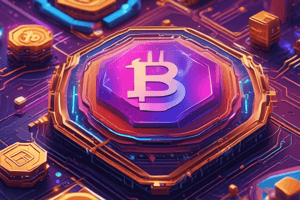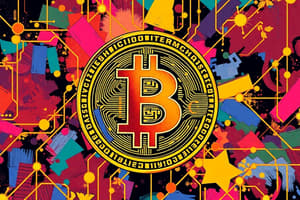Podcast
Questions and Answers
What is the main difference between Blockchain and traditional databases?
What is the main difference between Blockchain and traditional databases?
- Blockchain is a distributed ledger, while traditional databases are not. (correct)
- Blockchain is controlled by the government, while traditional databases are decentralized.
- Blockchain only stores fiat currency, while traditional databases store all types of currency.
- Blockchain uses physical blocks to store data, while traditional databases use electronic blocks.
What is the primary function of E-money?
What is the primary function of E-money?
- To store information about cryptocurrency transactions
- To provide physical coins and paper money
- To transfer monetary value equivalent to fiat currency electronically (correct)
- To replace fiat currency completely
What are the potential benefits of Virtual Currencies (VC's) for consumers?
What are the potential benefits of Virtual Currencies (VC's) for consumers?
- Limited access to financial services
- Uninsured holdings
- Slower transaction speeds
- Remittances & wire transfers (correct)
Which digital currency was introduced in 2014?
Which digital currency was introduced in 2014?
What makes VC transactions different from traditional banking transactions?
What makes VC transactions different from traditional banking transactions?
What is the key characteristic of E-money in terms of conversion?
What is the key characteristic of E-money in terms of conversion?
Which term refers to the new generation of fully digital banking services that aim to be more accessible than traditional banks?
Which term refers to the new generation of fully digital banking services that aim to be more accessible than traditional banks?
What is the distinguishing feature of Virtual Currency (VC) compared to traditional currencies?
What is the distinguishing feature of Virtual Currency (VC) compared to traditional currencies?
What technology is used in Cryptocurrency to carry out transactions in a decentralized manner?
What technology is used in Cryptocurrency to carry out transactions in a decentralized manner?
What is the main way Virtual Currencies (VCs) can be exchanged with actual cash (fiat money)?
What is the main way Virtual Currencies (VCs) can be exchanged with actual cash (fiat money)?
Which type of digital wallet is commonly used for storing Virtual Currencies (VCs)?
Which type of digital wallet is commonly used for storing Virtual Currencies (VCs)?
What term is used for a type of digital currency created by a community of online users and not guaranteed by central authorities?
What term is used for a type of digital currency created by a community of online users and not guaranteed by central authorities?
What technology allows two devices to process contactless payments using sound waves?
What technology allows two devices to process contactless payments using sound waves?
Which technology involves emitting a magnetic signal to imitate a credit card's magnetic strip for secure payments?
Which technology involves emitting a magnetic signal to imitate a credit card's magnetic strip for secure payments?
What method uses time-limited token numbers to process specific transactions in mobile wallets?
What method uses time-limited token numbers to process specific transactions in mobile wallets?
Which technology stores payment information on a mobile device usually in an app?
Which technology stores payment information on a mobile device usually in an app?
Which technology uses matrix barcodes readable by smartphones to enhance security in payments?
Which technology uses matrix barcodes readable by smartphones to enhance security in payments?
What type of technology confirms the phone owner's identity as the card owner for increased security?
What type of technology confirms the phone owner's identity as the card owner for increased security?
Flashcards are hidden until you start studying
Study Notes
Blockchain vs. Traditional Databases
- Blockchain is decentralized, while traditional databases are typically centralized.
- Data in blockchain is immutable and transparent, allowing for tamper-proof record-keeping.
Primary Function of E-Money
- E-money serves as a digital alternative to cash, enabling electronic transactions and payments.
Benefits of Virtual Currencies (VCs) for Consumers
- Lower transaction fees compared to traditional financial systems.
- Increased privacy and security for users.
- Accessibility to financial services for unbanked populations.
Digital Currency Introduced in 2014
- Ripple (XRP) was one of the notable digital currencies launched in 2014.
VC Transactions vs. Traditional Banking Transactions
- VC transactions are peer-to-peer, eliminating the need for intermediaries like banks.
- VCs enable real-time transfers, while traditional banking can have delays.
Key Characteristic of E-Money in Conversion
- E-money must be convertible to traditional fiat currencies at a fixed rate.
New Generation of Digital Banking Services
- Neo-banking refers to fully digital banking services designed for better accessibility compared to traditional banks.
Distinguishing Feature of Virtual Currency (VC)
- VCs operate independently of government regulation and are not backed by tangible assets.
Technology Used in Cryptocurrency Transactions
- Blockchain technology facilitates decentralized and secure transaction processing in cryptocurrencies.
Exchanging VCs with Fiat Money
- The primary method is through cryptocurrency exchanges, where VCs can be traded for cash.
Common Digital Wallet for Storing VCs
- Cryptocurrency wallets are commonly used for securely storing virtual currencies.
Digital Currency Not Guaranteed by Central Authorities
- Cryptocurrencies are created by communities and are not backed by any central government or authority.
Contactless Payment Technology Using Sound Waves
- Sound-based payment technology allows two devices to process payments without physical contact.
Magnetic Signal Technology for Payments
- Magnetic stripe emulation technology mimics traditional credit card magnetic strips for secure payment transfers.
Time-Limited Token Number Method
- Dynamic tokenization involves generating temporary token numbers for each transaction to enhance security.
Technology for Storing Payment Information on Mobile Devices
- Mobile wallets utilize applications on smartphones to store and manage payment information.
Matrix Barcodes for Enhanced Security
- QR codes improve security by allowing smartphone scanning for payment verification.
Technology for Confirming Card Ownership
- Biometric authentication confirms the identity of the phone owner as the cardholder for secure transactions.
Studying That Suits You
Use AI to generate personalized quizzes and flashcards to suit your learning preferences.




